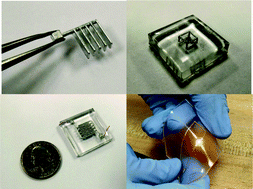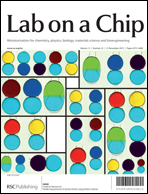3D structures of liquid-phase GaIn alloy embedded in PDMS with freeze casting
Abstract
Liquid phase electronic circuits are created by freeze casting gallium–indium (GaIn) alloys, such as eutectic gallium–indium (EGaIn), and encapsulating these frozen components within an elastomer. These metal alloys are liquid at room temperature, and can be cast using either injection or a vacuum to fill a PDMS mold and placing the mold in a freezer. Once solidified, a GaIn alloy segment can be manipulated, altered, or bonded to other circuit elements. A stretchable circuit can be fabricated by placing frozen components onto an elastomer substrate, which can be either patterned or flat, and sealing with an additional layer of elastomer. Circuits produced in this fashion are soft, stretchable, and can have complex 3D channel geometries. In contrast, current fabrication techniques, including needle injection, mask deposition, and microcontact printing, are limited to 2D planar designs. Additionally, freeze casting fabrication can create closed loops, multi-terminal circuits with branching features, and large area geometries.


 Please wait while we load your content...
Please wait while we load your content...